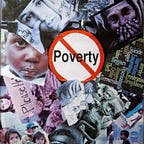Hunger and Poverty
Hunger has been an issue in this world for decades. As the population grows, it continues to affect millions of people around the world.
According to Cheng, “Hunger and Malnutrition primary target preschoolers, which mostly come from their malnourished mothers” (Pinstrup-Andersen & Cheng, 2007, September, p. 1). Fundamentally, hunger leads to even more hunger.
Although not all poor people are hungry, almost all hungry people are poor.
Cheng states, “The great majority — 75 percent — of the chronically underfed live in rural areas of developing countries. They are landless, frequently unemployed or employed at very low wages”(Pinstrup-Andersen & Cheng, 2007, September, p. 1). People in developing areas tend to experience food shortages more often than people who live in industrialized areas. Food insufficiency refers to insufficient food supplies to meet minimum daily diet requirements.
Siepel states, “During the past several decades, worldwide food supplies have more than doubled, and the average daily per capita food consumption has increased by 15 percent, but not all countries have had overall growth in food supplies” (Seipel, 1999, September, p. 6).
Various developing countries are economically unable to purchase available food from the exporting countries, which has led to food uncertainty and has left millions hungry and malnourished. The world needs to take action to stop the effects of hunger. Hunger leads to micronutrient deficiencies and widespread diseases.
A huge portion of the world has to fight every day just to put food on their plates.
Pinstrup-Andersen and Cheng note, “More than 800 million people — two and a half times the population of the U.S. — live every day with hunger, or ‘food insecurity,’ as it is often called, as their constant companion” (Pinstrup-Andersen & Cheng, 2007, September, p. 1).
People do not get essential vitamins or minerals in their diets, which leads to an increase in poverty. It is not the food shortage that is the problem, but the money.
Cheng says, “Enough food is now being produced to meet the energy and protein needs of every person on the planet, yet the problem of hunger still occurs because millions of households simply cannot afford to buy nutritious food” (Pinstrup-Andersen & Cheng, 2007, September, p. 1).
It is the unequal distribution of food among and within countries that has lead to world hunger being as prevalent and it is today. The world has to use innovation to solve these problems. For instance, Cheng states, “In China and India, government approval of the genetically modified cottonseed Bt cotton, whose plants are resistant to the attack of certain insects such as the cotton bollworm, has resulted in major economic gains for millions of small farmers” (Pinstrup-Andersen & Cheng, 2007, September, p. 4). Public investment in research and technology is needed to develop other innovations, and farmers and consumers should participate in setting priorities for this research. Valid governance and cooperation is the most important factor to stopping poverty.
Resources
Pinstrup-Andersen, P., & Cheng, F. (2007, September). Still hungry. Scientific American, 297(3), 96–103. https://doi.org/10.1038/scientificamerican0907-96
Seipel, M. M. O. (1999, September). Social consequences of malnutrition. Social Work, 44(5), 416–425. https://doi.org/10.1093/sw/44.5.416
